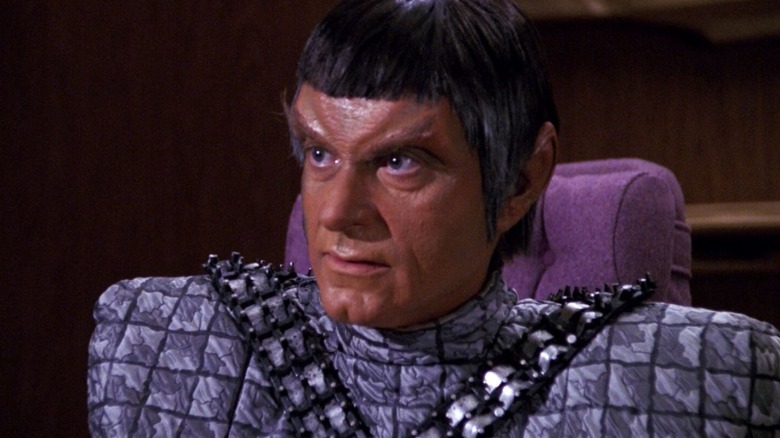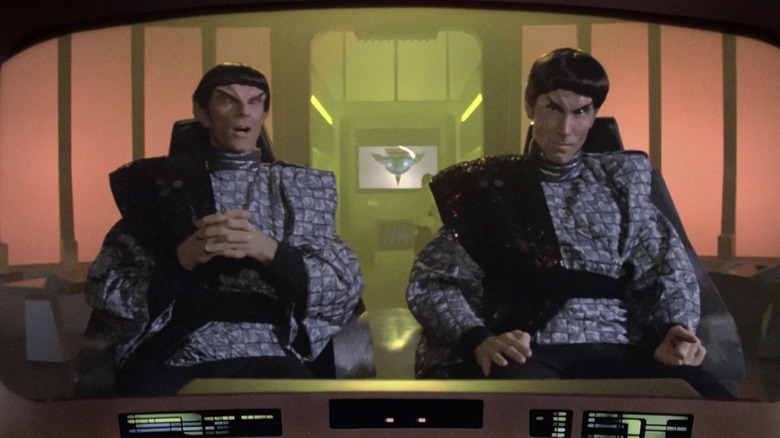Why Star Trek's Romulans Looked So Different When They Returned In The Next Generation
The first appearance of the Romulans on "Star Trek" came in the episode "Balance of Terror" (December 15, 1966), wherein the U.S.S. Enterprise faced off against a mysterious Romulan Bird-of-Prey. It was said in the episode that the Federation and the Romulans had previously fought a war, but, thanks to primitive communication technology, had never laid eyes on each other. After managing to hack into the Romulan computers, the crew of the Enterprise was able to spy on their enemies for the first time, finding that they looked a lot like Vulcans. The Romulan Commander (Mark Lenard) merely sported angled eyebrows and pointed ears, very much like Spock (Leonard Nimoy).
In a later episode called "The Enterprise Incident" (September 27, 1968), Kirk (William Shatner) and Spock find themselves on board a Romulan Bird-of-Prey facing off against a new Romulan Commander (Joanne Linville). It was the first time a human and a Romulan were depicted in the same room face-to-face. Romulans, we learn, are a strict, secretive, and dastardly Empire, and are exceptionally good at tactics and subterfuge. They remained a notable antagonist throughout "Star Trek" from then on.
The first time audiences saw Romulans on "Star Trek: The Next Generation" was in the episode "The Neutral Zone" (May 16, 1988), and they looked noticeably different. They now had larger ear points and raised ridged foreheads. The decision for the change, it seems, was not merely a matter of advanced makeup techniques. According to Paula M. Block and Terry J. Erdman's book "Star Trek: The Next Generation 365," makeup designer Michael Westmore aimed specifically to make the Romulans look more threatening.
Angry head
It's been acknowledged throughout "Star Trek" that the Vulcans and the Romulans were originally the same species, but separated long ago and evolved differently on different worlds. They are similar, yet not identical in anatomy. As such, the Romulans couldn't stray too far from the classical Vulcan design. Westmore noted:
"From the very first moment [Romulans] appeared on-screen, the viewer had to take them seriously, rather than seeing them as stereotyped villains with pointed ears. [...] The two races were completely different on a cultural level, but it wasn't that easy to tell them apart physically. They had the same basic skin color, they wore the same hairstyle, and both races had pointed ears and archless eyebrows. Aside from dressing them in different clothes, what were we going to do to bring out the diversity between them?"
What Westmore could do, though, is communicate instantly — through his forehead designs — that the Romulans were villains. Without adding a caveman-like brow, Westmore decided to build on their foreheads, explaining:
"I devised a forehead that had a dip in the center, and then I hollowed out the temple area. We wanted to stay close to their natural forehead, not making them look Neanderthal, but giving them a built-in sullen expression they couldn't get away from."
It works. The Romulans have, essentially, permanent "angry eyes." There has yet to be any in-universe explanation as to why the Romulans suddenly had enlarged foreheads 80 years after the events of the original series, but it's one of those details most Trekkies happily overlook. It would, however, eventually be canonically explained why Klingons looked more human in the original series and had enlarged foreheads in the "Next Generation" days; it turns out one of Data's ancestors tinkered with their DNA.

